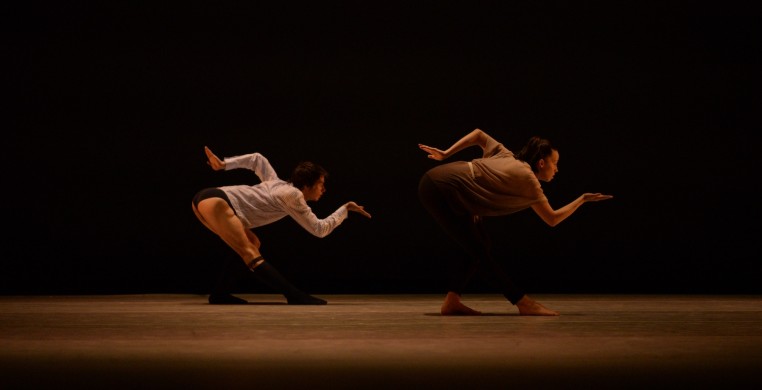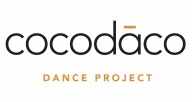Let’s get the hard part out of the way: Cocodaco Dance Project got in over its head by booking two nights on a solo bill at the North Shore Center for the Performing Arts. All signs pointed to “not quite ready” for this young, Evanston-based contemporary company, now under the direction of David Maurice. But given the recent transition to new leadership following the untimely death of founder Ronn Stewart in 2017, and a promising eye for production value, it’s hard not to admire that they went for it anyway, showing two pieces for the professional company Friday and Saturday, and a third for nine youth performers.
As the plush red velvet curtains rose on the opening piece called “Okinawa Beast,” and fog billowed into the audience amidst the dramatic swells of a Max Richter score, dancers Quincie Bean and Kristen Donovan walked slowly across the stage attached by a conjoined Rapunzel braid. In the upstage left corner is a shiny white figure, which turns out to be Maurice, huddling in the fetal position in a skin-tight latex suit. He spends several minutes peeling it off, like a snake shedding its skin, or a better metaphor might be trying to get a persistant pricetag sticker off in the absence of Goo Gone. How these two images fit together – the two women with hair braided together and Maurice in oppressive white latex – is a mystery, with the only commonality between them being the idea of confinement. Maurice breaks free of his, and while one of the women eventually parts ways with her end of the braid, I’m not sure it was intentional. The three then dance together, Maurice having quickly changed into rehearsal clothes over his mostly peeled-off unitard, with movement motifs that feel inspired by Gaga, a form developed by Israeli choreographer Ohad Naharin for his Batsheva Dance Company.
If I was in doubt of this influence, the evening’s finale, “A Giddy Whisper,” affirmed my suspicions that Maurice is following in the footsteps of Danielle Agami, a former Batsheva dancer who founded the Los Angeles-based company Ate9, which is part of Maurice's resume. (As part of its “Made in Chicago” series last November, the Auditorium Theatre hosted Ate9 in a triple bill with Deeply Rooted Dance Theater and Visceral Dance Chicago, who has commissioned work from Agami in the past.) The rules of this Gaga derivative favor randomness verging on absurdity, mainly by disrupting accepted choreographic norms; viscid, super-bendy, low-to-the-ground movement and a near complete abandonment of classical technique – though because of that affinity for unpredictability one will occasionally see a big arabesque, often turned in and sickled, or a big, sweeping gargouillade, just for fun. “A Giddy Whisper” is anchored by long stretches of text, also by Maurice, which seems to be about couples who don’t fully share truths about themselves for the sake of the relationship. On stage, the dancers line-up, one by one, to kiss one of their colleagues, or later, to take turns shoving another around. Frequent changes of pedestrian clothes and couplings or trios of dancers also allude to the complexities of dating, but, like “Okinawa Beast,” the through-line of this work is inchoate, amorphous, underdeveloped. Perhaps it's the intention to keep any overarching theme from bubbling to the surface; by far, the highlights of the evening were a solo danced beneath a sparkling disco ball which casts its magnificent glow across the whole house, and two pure dance sections performed in exacting unison to a thumping, driving musical pulse.
And that’s what made the evening so frustrating. This is an ensemble of excellent dancers with interesting ideas, better served by taking the time to develop the “why” of their work, in addition to the “what.” Gaga, at its core, is about letting dancers be real people on stage, and Ronn Stewart’s mission was all about love and inclusion. These motives are clearly present in Cocodaco’s new roster of dancers, which includes a refreshingly wide variety of people representing different ethnic backgrounds, body types and gender expressions. And maybe that – inclusion – is “the thing” at the heart of this company. But as the audience, I want to be included, too, by watching dances that get at something a bit more transparent, and connect me to the real people on stage.


